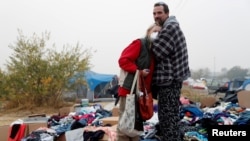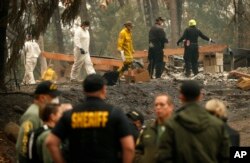The deadliest wildfire in California history has claimed at least 63 lives and left more than 600 people missing as firefighters gained ground in containing and suppressing the flames.
Some 500 rescue workers continued to sift through debris Friday for missing people in and around the northern California town of Paradise, one week after the deadly blaze, known as the Camp Fire, erupted and quickly raced through the town of 27,000. The blaze reduced it to ashes, having destroyed nearly 12,000 structures, including at least 9,700 homes, and still threatens thousands of additional structures.
The large number of missing people likely includes those who fled the fire and don't realize they have been reported missing, Butte County Sheriff Kory Honea said. Honea said a list of the missing was publicized so people can see if they are on it and inform authorities they survived.
When the fire broke out last week, Honea said, "The chaos that we were dealing with was extraordinary. Now we're trying to go back out and make sure that we're accounting for everyone."
The blaze forced the evacuation of some 52,000 people who are staying in shelters, motels, homes of relatives and friends, motels and at a makeshift camp on a nearby Walmart parking lot and an adjacent field.
One evacuee, Paradise resident Harold Taylor, told The Associated Press, "We didn't have 10 minutes to get out of there. It was already in flames downtown, all of the local restaurants and stuff."
Taylor said he unsuccessfully sought to convince a neighbor to escape with him and does not know what happened to him.
Sheriff Honea said the remains of seven more victims were recovered Thursday, raising the death toll to 63. Officials say they hope a Rapid DNA analysis technique will help speed the identification of victims and notification of their families.
The 570 square kilometer Camp Fire was 40-percent contained Thursday, but authorities could not predict when evacuees would be able to return to the area. Authorities said conditions are still too dangerous, citing ongoing firefighting efforts, downed power lines and road closures.
The cause of the Camp Fire remains under investigation, but officials have said they are investigating the possibility it was sparked by electrical equipment.
Wildfires are common in California, particularly at this time of year when warm, dry winds help fan the flames. At the southern end of California, firefighters and rescue workers have been grappling with other wildfires, including the Woosley Fire that killed three people and burned at least 500 structures near the Malibu coast near Los Angeles.
The Woosley Fire, which torched nearly 390 square kilometers, roughly the size of the western city of Denver, Colorado, was about 60 percent contained, allowing more residents to return to the area.
The White House announced that U.S. President Donald Trump would visit California on Saturday to meet with "individuals impacted by the wildfires." He plans to travel to both regions of California that have been devastated by the blazes.
Trump's visit comes a week after he initially blamed California officials for the wildfires and threatened to withhold federal money. His tweets did not mention California's drought conditions, which many scientists say are symptomatic of climate change.
California Governor Jerry Brown, U.S. Interior Secretary Ryan Zinke, and Brock Long, head of the emergency management agency, FEMA, visited the Paradise area on Wednesday. Brown blamed climate change and drought for the massive blaze, while Zinke cautioned against assigning blame to any one factor.
"Now is not the time to point fingers," Zinke said, saying dead trees, higher temperatures, and poor forest management were among the causes.
Long said it will take years for residents of Paradise to rebuild, if they choose to do so at all.










